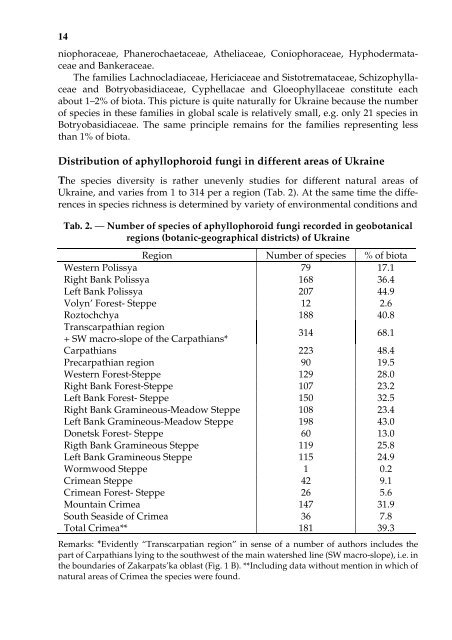Annotated checklist of aphyllophoroid fungi of Ukraine
Annotated checklist of aphyllophoroid fungi of Ukraine
Annotated checklist of aphyllophoroid fungi of Ukraine
Create successful ePaper yourself
Turn your PDF publications into a flip-book with our unique Google optimized e-Paper software.
14<br />
niophoraceae, Phanerochaetaceae, Atheliaceae, Coniophoraceae, Hyphodermataceae<br />
and Bankeraceae.<br />
The families Lachnocladiaceae, Hericiaceae and Sistotremataceae, Schizophyllaceae<br />
and Botryobasidiaceae, Cyphellacae and Gloeophyllaceae constitute each<br />
about 1–2% <strong>of</strong> biota. This picture is quite naturally for <strong>Ukraine</strong> because the number<br />
<strong>of</strong> species in these families in global scale is relatively small, e.g. only 21 species in<br />
Botryobasidiaceae. The same principle remains for the families representing less<br />
than 1% <strong>of</strong> biota.<br />
Distribution <strong>of</strong> <strong>aphyllophoroid</strong> <strong>fungi</strong> in different areas <strong>of</strong> <strong>Ukraine</strong><br />
The species diversity is rather unevenly studies for different natural areas <strong>of</strong><br />
<strong>Ukraine</strong>, and varies from 1 to 314 per a region (Tab. 2). At the same time the differences<br />
in species richness is determined by variety <strong>of</strong> environmental conditions and<br />
Tab. 2. — Number <strong>of</strong> species <strong>of</strong> <strong>aphyllophoroid</strong> <strong>fungi</strong> recorded in geobotanical<br />
regions (botanic-geographical districts) <strong>of</strong> <strong>Ukraine</strong><br />
Region Number <strong>of</strong> species % <strong>of</strong> biota<br />
Western Polissya 79 17.1<br />
Right Bank Polissya 168 36.4<br />
Left Bank Polissya 207 44.9<br />
Volyn’ Forest- Steppe 12 2.6<br />
Roztochchya 188 40.8<br />
Transcarpathian region<br />
314 68.1<br />
+ SW macro-slope <strong>of</strong> the Carpathians*<br />
Carpathians 223 48.4<br />
Precarpathian region 90 19.5<br />
Western Forest-Steppe 129 28.0<br />
Right Bank Forest-Steppe 107 23.2<br />
Left Bank Forest- Steppe 150 32.5<br />
Right Bank Gramineous-Meadow Steppe 108 23.4<br />
Left Bank Gramineous-Meadow Steppe 198 43.0<br />
Donetsk Forest- Steppe 60 13.0<br />
Rigth Bank Gramineous Steppe 119 25.8<br />
Left Bank Gramineous Steppe 115 24.9<br />
Wormwood Steppe 1 0.2<br />
Crimean Steppe 42 9.1<br />
Crimean Forest- Steppe 26 5.6<br />
Mountain Crimea 147 31.9<br />
South Seaside <strong>of</strong> Crimea 36 7.8<br />
Total Crimea** 181 39.3<br />
Remarks: *Evidently “Transcarpatian region” in sense <strong>of</strong> a number <strong>of</strong> authors includes the<br />
part <strong>of</strong> Carpathians lying to the southwest <strong>of</strong> the main watershed line (SW macro-slope), i.e. in<br />
the boundaries <strong>of</strong> Zakarpats’ka oblast (Fig. 1 B). **Including data without mention in which <strong>of</strong><br />
natural areas <strong>of</strong> Crimea the species were found.



